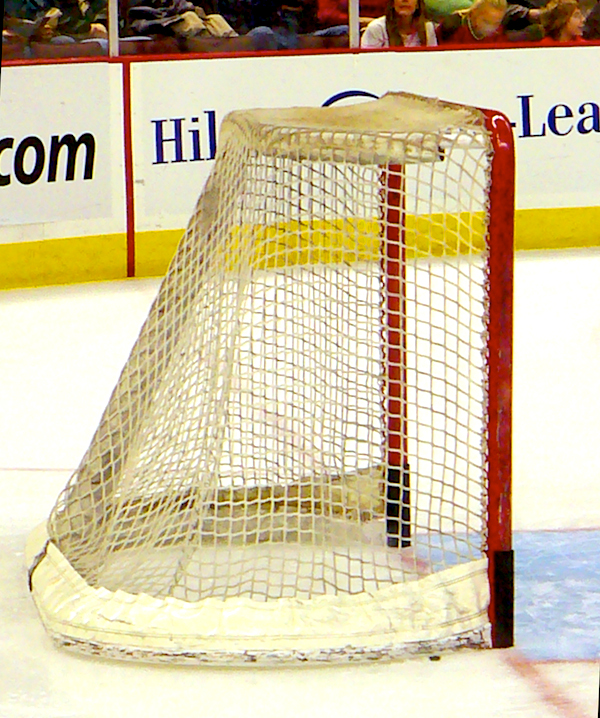Dear Sports Fan,
Why do people say goalies are crazy? What’s a goalie anyway?
Thanks,
Jean
Dear Jean,
When I was in middle school, I discovered ice hockey. I remember lying on my bed and watching games on a little square television at my Dad’s house. Even back then, I felt compelled to jot down interesting things I heard, as if I was preparing to write a blog, despite this being years before blogs existed and decades before I started Dear Sports Fan. I still have some of the quotes I wrote down. One of them was about goalies:
Some people say 90% of goaltending is mental. I say 90% of goaltenders are mental!
I’m not positive who said that but it’s a safe bet that it was John Davidson, a former NHL goalie who was then the color commentator for the New York Rangers. He and partner Sam Rosen were definitely the most common hockey voices in my early memories of the sport. Goaltenders or goalies are frequently described as being a little bit crazy. It’s unclear whether the position attracts players who are a little bit… different or whether the position takes normal people and twists them. My guess is that it’s a little bit of both. In order to appreciate the colorful nature of goalies, it’s important to understand what the position entails.
The position of goaltender exists in many sports: soccer, ice hockey, field hockey, lacrosse, team handball, and water polo. In each sport, the goalie is the most specialized position. She exists solely to do whatever she can to prevent the other team from scoring. Usually the goalie is granted special privileges in order to help them in their task. The most dramatic of those is in soccer where the goalie is the only player who can use his hands. In ice hockey, the goalie gets to wear thick leg pads, a large chest protector, a catching glove on one hand and a blocker and wide stick in the other. An ice hockey goalie also has special rules which apply only to her, including protection against being hit. Lacrosse goalies are allowed to have sticks with much larger heads than other players to make it easier to block shots with them. Water polo goalies are allowed to touch the ball with two hands and even touch the bottom of the pool.
You might think all those extra privileges make goalie the easiest position to play. Not true! The extra privileges of the goalie in most sports are a recognition of how difficult their job is. The margin of error for goalies in lower scoring sports (which is most goalies because, not coincidentally, there’s a strong correlation between having a goalie and having a low-scoring sport) is tiny and the consequences for error are enormous. Take poor Robert Green, for instance. In 2010 he was one of the best 40 people in the entire world at his profession yet all he will be remembered for (literally, it’s going to be the first line of his obituary one day) will be this momentary lapse against the United States in the World Cup. Hockey goalies who save 90% of the shots they face are probably not going to last long in the NHL where the best goalies save over 92.5% of the shots they face. Compare that to a non-goalie who scores on 20% of the shots he takes and is celebrated as an extraordinary goal-scorer. Even in a relatively high scoring sport like team handball, where, according to the New York Times, a goalie “can allow as many as 30 goals and still be thought to have had a good game” being a goalie comes with its down-side. Goalies are so frequently injured by shots that the international federation in charge of the sport is considering changing its rules to reduce injuries.
The challenges and pressure that goalies face seems to attract or create two types of people: those who compensate through obsessive behavior and those who compensate through aberrant behavior. Almost all goalies are one of the two types, some are both. Hockeygrrl lists some of the more well-known obsessive behavior in her post about hockey goalies, including Patrick Roy’s refusal to let anything, even ice shavings into his net, Henrik Lundqvist’s ritual of tapping the wall the same number of periods he’s played so far in the game, and my new favorite, Jocelyn Thibault’s tradition of pouring “water over his head precisely six-and-a-half minutes before a game began.” For the more far-out their behavior on the other side of the spectrum, see Colombian soccer goalie Rene Higuita, who was literally nicknamed “the lunatic” and hockey goalie Ilya Bryzgalov who once responded to a question about the offensive threats on an opposing team by saying that he was “only afraid of [a] bear.”
No matter how you cut it, goalies are some of the most important and most colorful people in sports.
Thanks for reading,
Ezra Fischer


